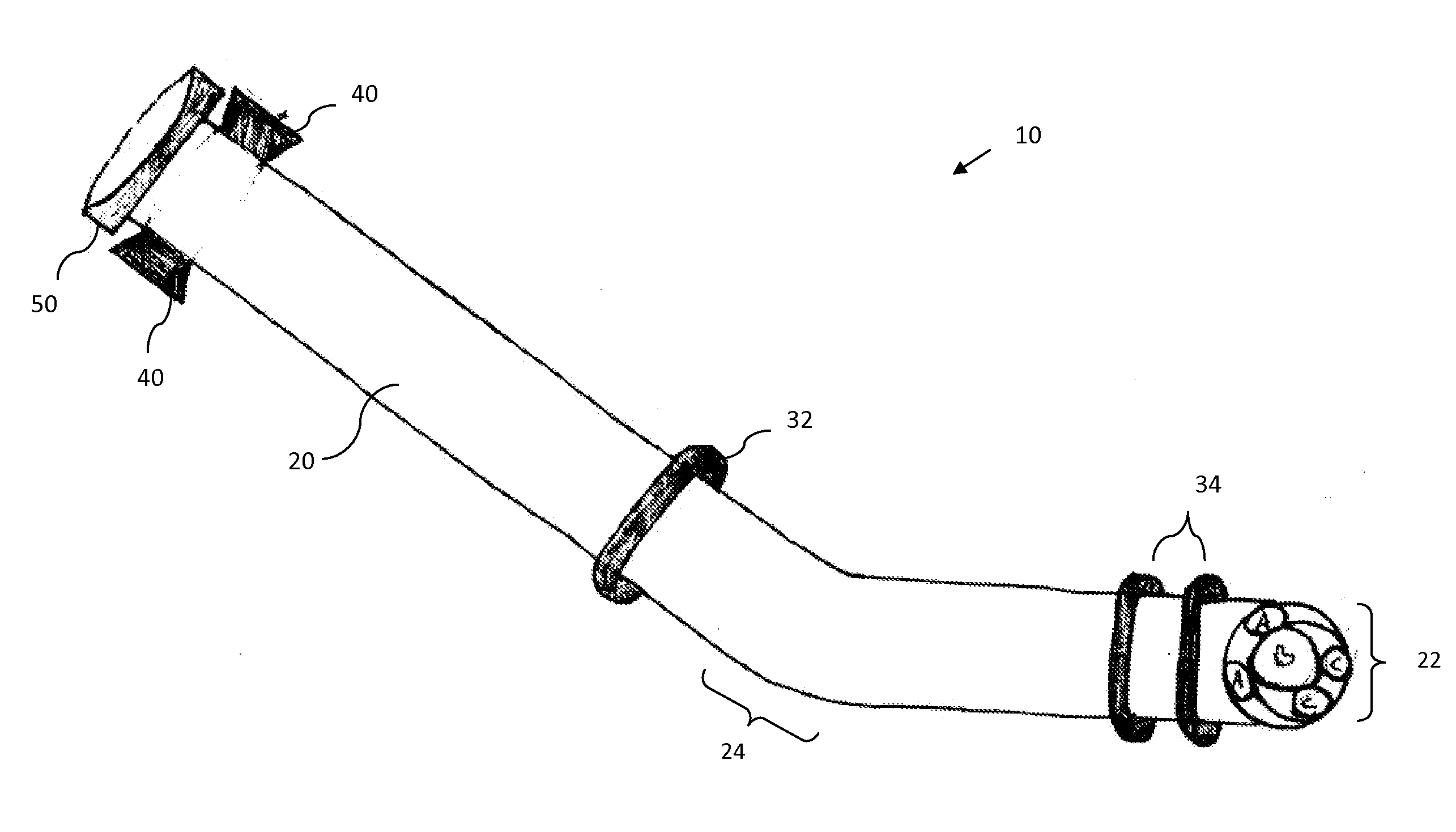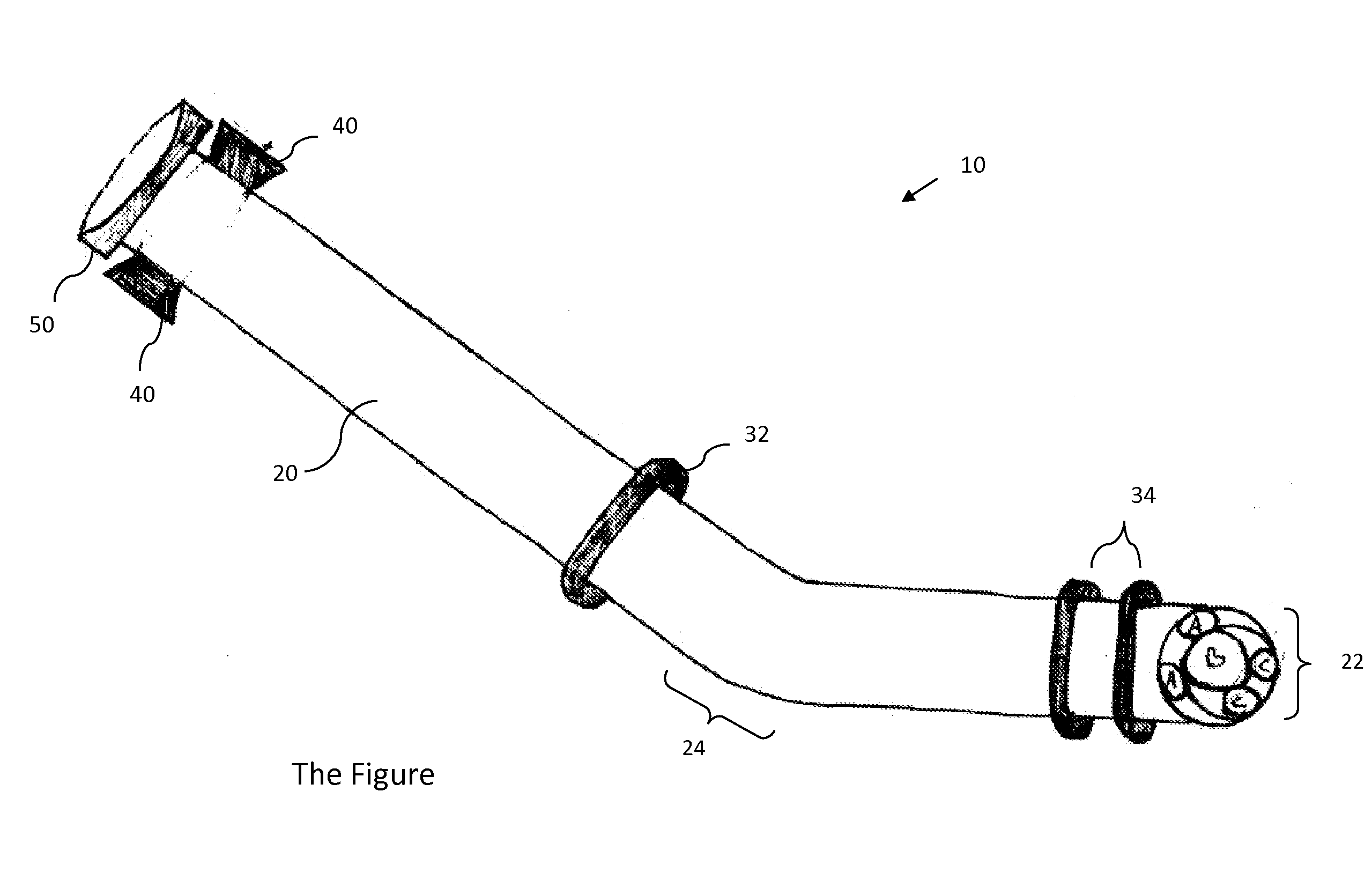[0005]An endoscopic guide for natural orifice transluminal
endoscopic surgery. This invention addresses a variety of problems associated with endoscopic
upper gastrointestinal access into and through the
stomach anterior wall. The device is a semi-flexible over-tube extending from the incisors through the esophagus and stomach and out into the peritoneum. It has a
bite block for
insertion and retention in the mouth of the patient. The over-tube sheaths and protects the esophagus and guides an
endoscope as well as various other instruments, through the stomach and out via the
anterior wall into the peritoneum. This device avoids re-
intubation of the esophagus, promotes safe and easy access with increased efficiency and accuracy of
insertion of the endoscope and other instruments, minimizes risks of perforation or other mucosal injuries, and allows secure control of the gastrotomy. An overtube that extends all the way from mouth to
peritoneal cavity will prevent these kind of risks. The device avoids the loss of
pneumoperitoneum during the operation. Re-insertions of instruments and endoscopes into the peritoneal cavity may lead to loss of anterior gastric wall access which in turn would lead to loss of
pneumoperitoneum. The device further avoids the loss of anterior gastric wall access into the peritoneum. Re-insertions of instruments and endoscope into the peritoneal cavity may lead to loss of anterior gastric wall access which in turn would increase the
operative time that is spent on re-establishing gastric access This can be more difficult to achieve because of the already existing gastrotomy or gastric wall defect which prevents intraluminal gastric insufflation that allows to identify the previous opening and reinsert instruments and scope.
[0006]For the patient, the device decreases the total physician and support
staff time spent on any given procedure resulting in a net benefit to the patient's health and overall prognosis as a result of a decrease in potential procedure complications and reduced time under
anesthesia. To the institution and the clinician, the device will result in decrease in the overall
procedure time, which, in turn, reduces the potential for patient complications and, by implication, reduces
recovery time and those costs associated thereof.
[0007]In a first aspect the present invention provides an endoscopic
guide tube. The
guide tube includes a semi-flexible
hollow cylinder having a distal and proximal end, a first expandable
balloon affixed peripherally about the semi-flexible
hollow cylinder and positioned on the
hollow cylinder so as to occlude the esophageal lumen upon inflation of the first expandable
balloon, a second and third expandable balloons affixed peripherally about the flexible hollow cylinder adjacent to the distal end of the semi-flexible hollow cylinder, the second and third expandable balloons securing the semi-flexible hollow cylinder upon inflation of the balloons thereby providing direct access to the peritoneum and allowing the insertion, manipulation and removal of instruments during a procedure, a
bite block adjacent to the proximal end of the semi-flexible hollow cylinder and a valve at the proximal end of the flexible hollow cylinder. The valve allows for the sealing of the lumen of the cylinder from the external environment thereby preventing leaking or insufflation and allowing access to the flexible hollow cylinder for insertion, removal and manipulation of instruments during a procedure. The cylinder of the guide is to be inserted into a
body cavity to guide the distal end portion of the flexible tube of an endoscope into the
body cavity.
[0009]In a second aspect the present invention provides a second embodiment of an endoscopic
guide tube. The guide tube includes a semi-flexible hollow cylinder having a distal and proximal end and a first and second expandable balloons affixed peripherally about the flexible hollow cylinder adjacent to the distal end of the semi-flexible hollow cylinder. The first and second expandable balloons secure the semi-flexible hollow cylinder upon inflation thereby providing direct access to the peritoneum and allowing the insertion and removal of instruments during a procedure.
[0010]In a third aspect aspect the present invention provides a third embodiment of an endoscopic guide tube. The guide tube includes a semi-flexible hollow cylinder having a distal and proximal end, a first and second expandable balloons affixed peripherally about the flexible hollow cylinder adjacent to the distal end of the semi-flexible hollow cylinder and a valve at the proximal end of the flexible hollow cylinder. The valve allows for the sealing of the lumen of the cylinder from the external environment thereby preventing leaking or insufflation and allowing access to the flexible hollow cylinder for insertion, removal and manipulation of instruments during a procedure. The first and second expandable balloons secure the semi-flexible hollow cylinder upon inflation thereby providing direct access to the peritoneum and allowing the insertion and removal of instruments during a procedure.
 Login to View More
Login to View More  Login to View More
Login to View More 

